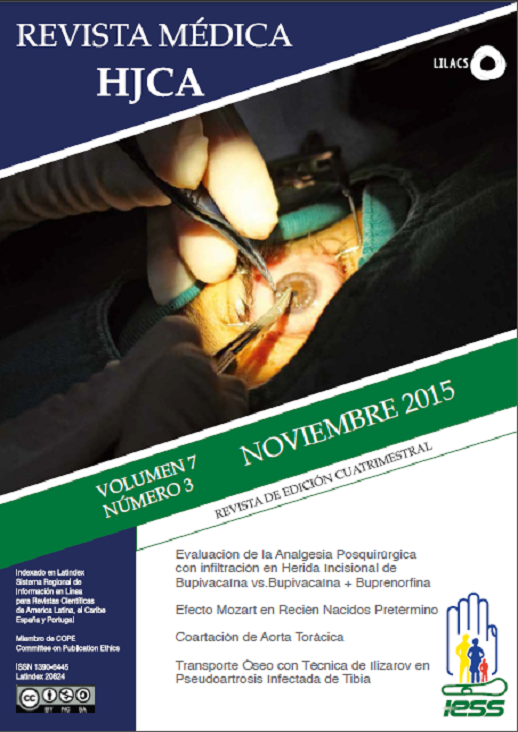Fracturas de Radio Distal: Características Clínicas, Tratamiento y Complicaciones
Palabras clave:
FRACTURAS DEL RADIO, CLASIFCACIÓN, SIGNOS Y SÍNTOMAS, TERAPÉUTICA, RADIUS FRACTURES, CLASSIFICATION, SIGNS AND SYMPTOMS, THERAPEUTICSResumen
INTRODUCCIÓN: Las fracturas de radio distal son un tema importante por la variedad de tratamientos y clasificaciones utilizadas para su abordaje, los mismos que son dependientes de variadas características tanto de la lesión como del paciente. El objetivo del estudio fue describir las características clínicas de las fracturas de radio distal, su tratamiento y las complicaciones asociadas.
MÉTODOS: El presente es un estudio descriptivo retrospectivo, se incluyeron los pacientes atendidos en el servicio de Emergencia del hospital “José Carrasco Arteaga” durante 18 meses de enero de 2014 a junio de 2015; los pacientes fueron diagnosticados de fractura de radio distal, se excluyeron los pacientes que abandonaron el servicio o se transfirieron; las variables estudiadas fueron sexo, edad, lado afecto, complicaciones, hueso afecto, mecanismo de
lesión y tratamiento realizado.
RESULTADOS: Se estudiaron 214 pacientes, los rangos de edad más frecuentemente afectados fueron los comprendidos entre 10 y 19 años de edad y 40 y 49 años con el 21.96% y 13.55% respectivamente; la afectación en el sexo masculino alcanzó un 52.34%, la afectación del lado izquierdo fue la más frecuente (51.4%), seguida de la afectación derecha con el 46.26%; las caídas constituyeron el principal mecanismo de lesión (92.52%), los tratamientos más empleados fueron la reducción cerrada más yeso (52.8%) y la colocación de agujas de Kirschnner (35.05%), las complicaciones alcanzaron un 4.21%.
CONCLUSIÓN: Las fracturas de radio distal constituyen una patología muy frecuente que afecta principalmente a pacientes del sexo masculino, con edades entre 10 y 19 años; el miembro afectado con mayor frecuencia es el izquierdo; el tratamiento principalmente utilizado es la reducción cerrada más yeso, las complicaciones derivadas del tratamiento fueron infrecuentes.
ABSTRACT
Distal Radial Fractures: Clinical Characteristics, Treatment and Complications.
BACKGROUND: Distal radial fractures are an important issue because of the variety of treatments and classifications used for its approach, which are dependent of many characteristics of the injury and of the patient. The objective of this research was to describe the clinical characteristics
of distal radial fractures, its treatment and associated complications.
METHODS: This is a descriptive retrospective research, it included outpatients who attended to Emergency department of “José Carrasco Arteaga” hospital during 18 months from January of 2014 to june of 2015; these patients were diagnosed with distal radial fracture and those who abandoned the service or were transferred, were excluded; studied variables were age, sex, affected side, complications, affected bone, injury mechanism and treatment.
RESULTS: 214 patients were studied, age ranges most frequently affected were those comprehended between 10 and 19, and 40 and 49 years old with 21.96% and 13.55% respectively. Male sex affectation reached 52.34%, left side affectation was the most frequent (51.4%), followed by the right side with 46.26% of the cases. Fall constituted the main injury mechanism representing 92.52%, the most used treatments were the closed reduction with plaster (52.8%) and Kirschnner’s
needles placement (35.05%), complications reached 4.21%.
CONCLUSIONS: Distal radial fractures are a very frequent pathology which affects mainly male sex patients with age between 10 and 19 years; the left upper limb is most commonly affected; the most used treatment is the closed reduction with plaster and complications from procedure were infrequent.
KEYWORDS: /, ,

